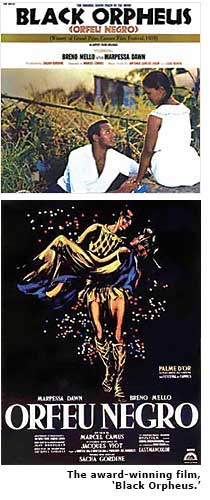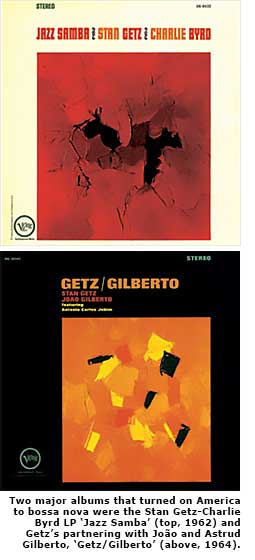Bossa Nova: Music of Modern Love - Page 2

Other Brazilian singers, including Dick Farney and Lúcio Alves, were already emulating the more naturalistic style of Sinatra. The future stars of bossa, including Nara Leão, Roberto Menescal, and Sylvia Telles, were listening to domestic and imported recordings in their stylish apartments. Gilberto, when not singing, became known for his flights of virtuoso guitar at the clubs that dotted Rio's waterfront neighborhoods. He met others who worked and hung out there, including pianists Johnny Alf and Tom Jobim and poet Vinícius de Moraes.
More and more modern apartment buildings sprung up, alongside hotels, with vistas of the Atlantic and the Rodrigo de Freitas Lagoon. On the street below, Jobim remembered, "Ipanema was a strip of sand between the sea and the lagoon. There was a channel, where the fish used to come in to spawn in the lagoon, in crystal clear water. We were there, we were young, and the sand was fine and clean and white. We knew the people that lived there, we knew each other."
In college, Jobim at first studied architecture, inspired by the modernist movement. But he was ultimately less interested in designing contemporary apartment houses than in creating a brighter soundtrack for the lifestyle that inhabited them.
"Brazilian music [had been] very negative," Jobim pointed out. Samba-canções had indulged in melodrama, "saying 'Oh, no, no—I don't want your kisses.'" With the advent of bossa songwriting, Jobim continued, "Vinícius started to sing, 'Yes, yes', like Cole Porter: 'Let's do it, let's fall in love.'" (It can be assumed that Jobim didn't intend to overlook those bossas that would deal with some of the sadder sides of love, such as his and Vinícius's own 'Insensatez.')
De Moraes, who had a separate (and financially dependable) career as a diplomat, returned from a posting in Paris in 1956 and approached Jobim with the concept that would become 'Black Orpheus,' which he'd been incubating while overseas. He and Jobim began collaborating on songs for the theatrical version, which opened that year, with a set designed by architect Niemeyer and the sound of Orpheus's guitar provided by the virtuosic Luiz Bonfá.
Meanwhile, João Gilberto was wandering around Brazil, seeking an inner vision and developing a percussive, plangent style that would become the envy of all guitarists, amateurs and veterans alike. As yet unnamed, this style bore the swing of samba, but made samba's elements sound sweetly from a single instrument, with 'altered' chords that evoked both African folk music and the sophistication of jazz.

Gilberto, as yet unknown, delivered the new style to those who would listen when he returned to Rio in 1957, accompanying himself with a new way of singing. His voice was free of vibrato and drama, airy in the manner of West Coast Cool jazzman Chet Baker, when Baker put his horn aside to sing.
Hélcio Melito remembers a walk on the beach with Gilberto, who shared his urgency to evolve past older styles: "With this kind of [older] samba, we're never gonna get out of here. We need to do something."
Jobim, who obviously shared Gilberto's sentiments, quickly perceived how well the guitarist-singer's quiet, fluid approach could be adapted to some of the songs Jobim had been writing with de Moraes outside of the 'Orpheus' project. Gilberto was brought in to back singer Elizeth Cardoso on an album of those songs, among them 'Chega de saudade,' released in spring of 1958. A few weeks later, Gilberto accompanied himself on his own 78-rpm single of the song. João's version of 'Chega de saudade' became a hit, later to be credited as the first for bossa nova and translated as 'No More Blues.'
As a genre name, bossa nova was christened at a college concert during that same year. "The bossas are these lumps that we have on the cranium," Jobim explained. "In the old days, medicine thought these protuberances had to do with the brain. So you would say that John has bossa for painting, and Larry has bossa for futbol. It's a 'gift.'"
What was it that made bossa 'nova,' or new? "It was the rhythm, the swing," Jobim pointed out. "It was João Gilberto with his guitar, the beat of bossa nova."
By the end of 1958, the term 'bossa nova' had appeared in the lyrics to what would be another of the genre's early (and ultimately international) hits, 'Desafinado,' composed by Jobim and journalist Ronaldo Bôscoli and recorded by Gilberto.




